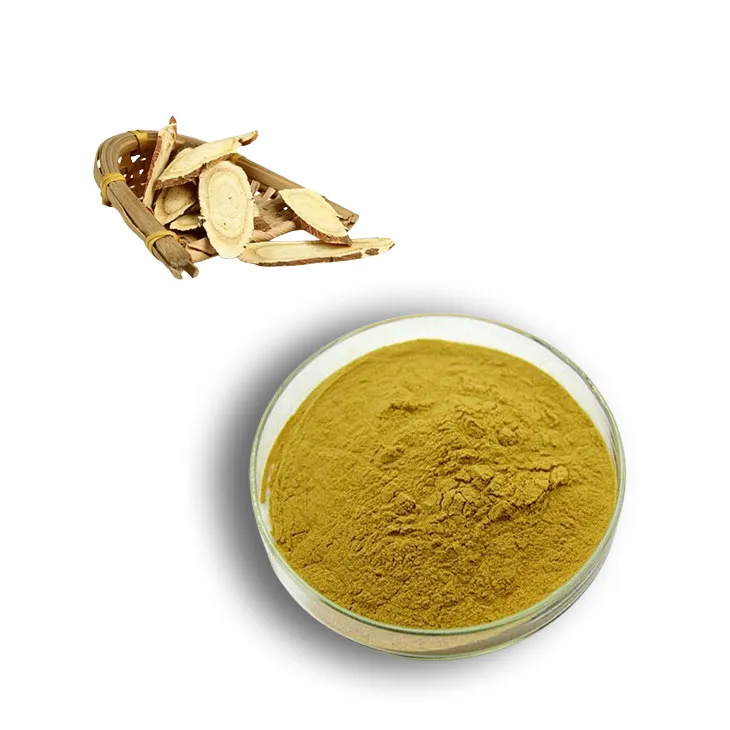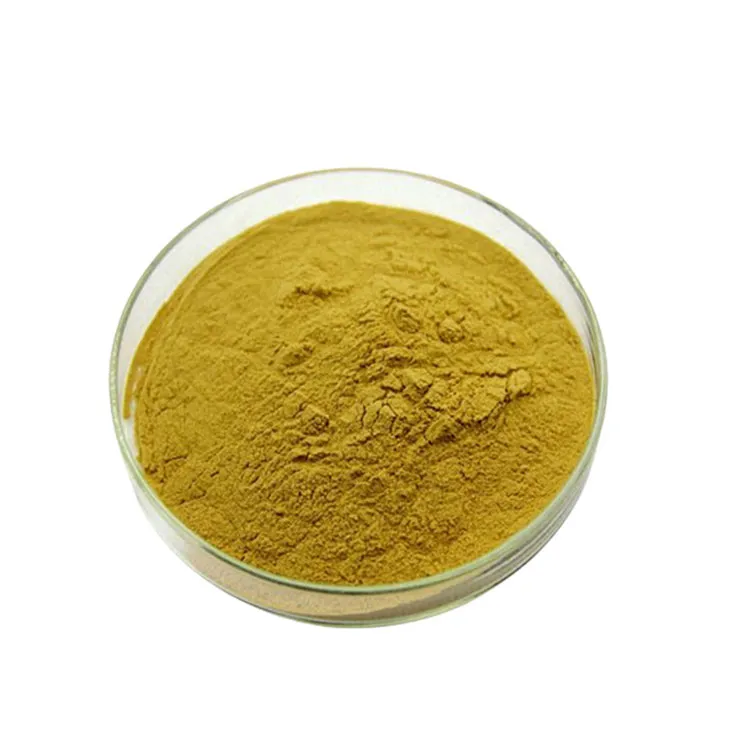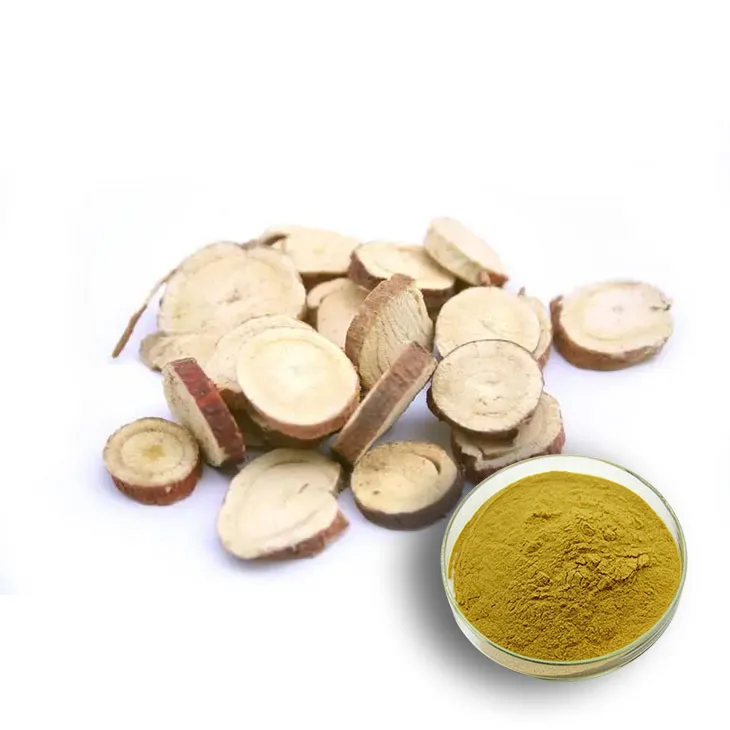- 0086-571-85302990
- sales@greenskybio.com
Active ingredients in licorice root extract powder.
2024-11-28

Introduction
Licorice Root Extract Powder has been used for centuries in various traditional medicine systems around the world. Its diverse range of potential health benefits can be attributed to the numerous active ingredients it contains. These active ingredients not only give licorice its characteristic taste but also endow it with a variety of pharmacological properties. In this article, we will take a closer look at some of the key active ingredients in Licorice Root Extract Powder and their functions.

Glycyrrhetinic Acid
Glycyrrhetinic acid is one of the most important active ingredients in Licorice Root Extract Powder. It has been the subject of extensive research due to its remarkable pharmacological properties.
Anti - ulcer Properties
One of the significant functions of glycyrrhetinic acid is its anti - ulcer properties. The gastric mucosa is constantly exposed to various factors that can cause damage, such as excessive acid secretion in the stomach. Certain drugs can also have a negative impact on the gastric mucosa. Glycyrrhetinic acid can protect the gastric mucosa from such damage. It does this by several mechanisms. For example, it may enhance the production of mucus in the stomach. Mucus forms a protective layer over the gastric mucosa, preventing the acid and other harmful substances from directly contacting the mucosal cells. Additionally, glycyrrhetinic acid may also influence the regulation of gastric acid secretion, helping to maintain a proper acid - base balance in the stomach.
Immunomodulatory Effects
Glycyrrhetinic acid also has immunomodulatory effects. It can interact with the immune system in different ways. For instance, it may modulate the activity of immune cells such as macrophages and lymphocytes. Macrophages are important cells in the innate immune system that play a role in phagocytosis and antigen presentation. Glycyrrhetinic acid can enhance the phagocytic activity of macrophages, which means they can more effectively engulf and eliminate foreign pathogens. In terms of lymphocytes, which are key players in the adaptive immune system, glycyrrhetinic acid can influence their proliferation and cytokine production. This helps in regulating the overall immune response in the body, either enhancing it when needed, such as during an infection, or suppressing it in cases of autoimmune disorders.

Licochalcone
Licochalcone, another active component in licorice root extract powder, has attracted much attention for its unique properties.
Anti - fungal Activities
Licochalcone has demonstrated strong anti - fungal activities. Fungal infections can be a significant problem, especially in individuals with weakened immune systems or in certain environmental conditions. Licochalcone can inhibit the growth of fungi. It does this by interfering with various aspects of the fungal life cycle. For example, it may disrupt the cell membrane of fungi. The cell membrane is crucial for maintaining the integrity and function of fungal cells. By disrupting it, licochalcone can cause leakage of intracellular components, ultimately leading to the death of the fungal cell. Moreover, licochalcone may also affect the synthesis of fungal cell walls. Since the cell wall provides structural support to the fungus, any interference in its synthesis can prevent the fungus from growing and multiplying.
Potential Anti - inflammatory Effects
There is also evidence suggesting that licochalcone may have anti - inflammatory effects. Inflammation is a complex biological process that can be triggered by various factors, including infections, tissue damage, and autoimmune reactions. Licochalcone may act on the molecular pathways involved in inflammation. For example, it may inhibit the production of certain pro - inflammatory cytokines. Cytokines are small proteins that play a crucial role in cell - to - cell communication in the immune system. By reducing the production of pro - inflammatory cytokines, licochalcone can help to dampen the inflammatory response in the body, potentially providing relief in inflammatory conditions.

Phenolic Compounds
The presence of phenolic compounds in licorice root extract powder is another important aspect of its composition.
Anti - oxidative Activities
Phenolic compounds are well - known for their anti - oxidative activities. Oxidative stress occurs when there is an imbalance between the production of reactive oxygen species (ROS) and the body's antioxidant defense mechanisms. ROS can cause damage to cells, proteins, and DNA, which is associated with various diseases, including aging, cancer, and neurodegenerative disorders. The phenolic compounds in licorice root extract powder can scavenge ROS. They have the ability to donate electrons to these highly reactive molecules, thereby neutralizing them and preventing them from causing damage. Some of the phenolic compounds in licorice, such as flavonoids, are particularly effective antioxidants. They can protect cells from oxidative damage, maintaining the normal function of cells and tissues.
Anti - microbial Activities
In addition to their anti - oxidative properties, phenolic compounds also contribute to the anti - microbial activities of licorice root extract powder. They can inhibit the growth of a wide range of microorganisms, including bacteria, fungi, and viruses. The anti - microbial mechanism of phenolic compounds may involve disrupting the cell membranes of microorganisms. Similar to their effect on fungal cells, they can cause leakage of intracellular contents in bacteria, leading to cell death. For viruses, phenolic compounds may interfere with the attachment or entry of the virus into host cells, preventing viral replication and spread.

Applications of Licorice Root Extract Powder Based on Active Ingredients
The active ingredients in licorice root extract powder form the basis for its potential applications in different fields.
Pharmaceutical Applications
- Due to its glycyrrhetinic acid content, licorice root extract powder can be used in the development of drugs for treating gastric ulcers. It can be formulated into medications that help protect the gastric mucosa and promote ulcer healing.
- The anti - fungal properties of licochalcone make licorice root extract powder a potential candidate for the development of antifungal drugs. It may be useful in treating fungal infections, especially those that are resistant to conventional antifungal agents.
- The immunomodulatory effects of glycyrrhetinic acid also suggest that licorice root extract powder could be explored for use in immunotherapy. It may be able to enhance the immune response in patients with certain cancers or immunodeficiency disorders.
Nutraceutical Applications
- The antioxidant properties of phenolic compounds in licorice root extract powder make it a valuable ingredient in nutraceuticals. It can be added to dietary supplements to help combat oxidative stress and promote overall health.
- Given its potential anti - inflammatory effects, licorice root extract powder may also be used in nutraceuticals aimed at reducing inflammation in the body. This could be beneficial for individuals with chronic inflammatory conditions such as arthritis.
Cosmeceutical Applications
- The anti - oxidative and anti - microbial activities of licorice root extract powder make it suitable for use in cosmeceutical products. It can be added to skin creams, lotions, and serums to protect the skin from oxidative damage and prevent microbial infections.
- Some of the active ingredients in licorice root extract powder may also have skin - whitening properties. For example, certain phenolic compounds may inhibit the production of melanin, the pigment responsible for skin color. This makes licorice root extract powder a potential ingredient in skin - whitening cosmeceuticals.
Conclusion
In conclusion, licorice root extract powder contains a rich variety of active ingredients, including glycyrrhetinic acid, licochalcone, and phenolic compounds. Each of these active ingredients has its own unique properties and functions, which together contribute to the diverse potential applications of licorice root extract powder in pharmaceutical, nutraceutical, and cosmeceutical fields. However, it is also important to note that while licorice root extract powder has many potential benefits, excessive use may also have some side effects. Further research is still needed to fully understand the mechanisms of action of these active ingredients and to optimize their use in various applications.
FAQ:
What are the main active ingredients in licorice root extract powder?
The main active ingredients in licorice root extract powder include glycyrrhetinic acid, licochalcone, and phenolic compounds.
How does glycyrrhetinic acid in licorice root extract powder act?
Glycyrrhetinic acid has anti - ulcer properties. It can protect the gastric mucosa from damage caused by factors such as excessive acid secretion or certain drugs.
What is the role of licochalcone in licorice root extract powder?
Licochalcone has anti - fungal activities. It can inhibit the growth of fungi, which is beneficial for treating fungal infections.
How do phenolic compounds in licorice root extract powder contribute?
Phenolic compounds in licorice root extract powder contribute to its anti - oxidative and anti - microbial activities. They work together to provide protection against various environmental stressors and pathogens.
What are the potential applications of licorice root extract powder based on its active ingredients?
Based on its active ingredients, licorice root extract powder has potential in pharmaceutical, nutraceutical, and cosmeceutical applications.
Related literature
- The Active Compounds in Licorice Root and Their Therapeutic Applications"
- "Licorice Root Extract: Composition, Properties, and Health - related Benefits"
- "Unraveling the Active Ingredients of Licorice Root for Cosmeceutical Use"
- ▶ Hesperidin
- ▶ citrus bioflavonoids
- ▶ plant extract
- ▶ lycopene
- ▶ Diosmin
- ▶ Grape seed extract
- ▶ Sea buckthorn Juice Powder
- ▶ Beetroot powder
- ▶ Hops Extract
- ▶ Artichoke Extract
- ▶ Reishi mushroom extract
- ▶ Astaxanthin
- ▶ Green Tea Extract
- ▶ Curcumin Extract
- ▶ Horse Chestnut Extract
- ▶ Other Problems
- ▶ Boswellia Serrata Extract
- ▶ Resveratrol Extract
- ▶ Marigold Extract
- ▶ Grape Leaf Extract
- ▶ blog3
- ▶ blog4
-
Nature's best vitamin D3.
2024-11-28
-
The best velvet antlers in 2024.
2024-11-28
-
Mango flavored powder
2024-11-28
-
Eyebright Extract
2024-11-28
-
Coix Seed Extract
2024-11-28
-
Artichoke Extract
2024-11-28
-
Plantain extract
2024-11-28
-
Tormentil Extract
2024-11-28
-
Saw Palmetto Extract
2024-11-28
-
Peppermint Oil
2024-11-28
-
Licorice Root Extract Powder
2024-11-28
-
Nutmeg Extract
2024-11-28




















